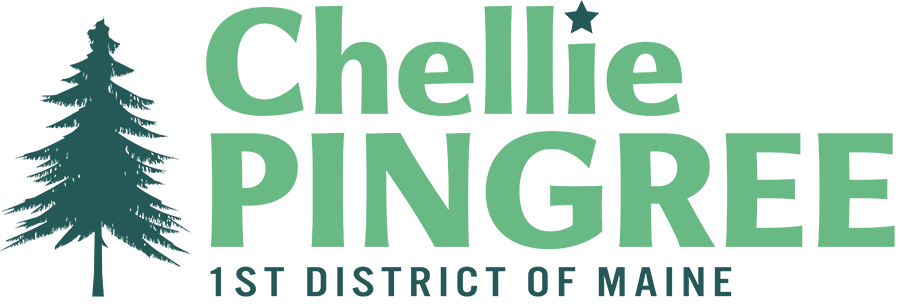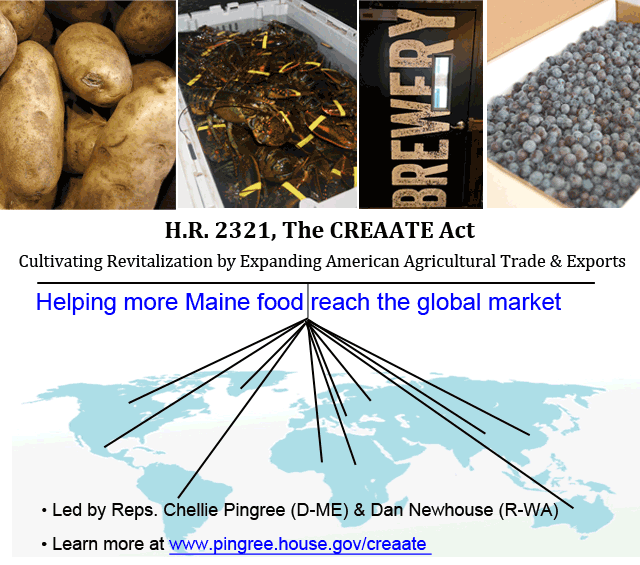Press Releases
Maine food businesses and industry groups cheer Pingree’s bipartisan legislation to grow agriculture and seafood exportsCREAATE Act increases funding for two USDA programs that help Maine foods reach global market
Washington, DC,
May 11, 2017
Tags:
Food and Agriculture
CREAATE Act increases funding for two USDA programs that help Maine foods reach global market
Maine food businesses and industry groups are cheering legislation Congresswoman Chellie Pingree (D-ME) introduced last week with Congressman Dan Newhouse (R-WA) to help grow exports for fishermen, farmers, and food manufacturers in Maine and across the country. H.R. 2321, the Cultivating Revitalization by Expanding American Agricultural Trade and Exports (CREAATE) Act would double funding for two federal programs that have been instrumental in helping more Maine food get to foreign markets—U.S. Department of Agriculture’s Market Access Program (MAP) and Foreign Market Development Program (FMDP). “These programs are vital to helping iconic Maine foods—like lobster, potatoes and wild blueberries—and many other value-added food products reach the world market,” said Pingree. “The Market Access Program and the Foreign Market Development Program at USDA have been extremely successful in helping farmers, fishermen and food businesses in Maine export products when supply exceeds the local market’s capacity. But these programs are currently underfunded, meaning that Maine businesses are losing out on opportunities to grow their sales and create jobs. Increased funding for these two programs would provide vital support to Maine industries that want to reach new markets abroad.” "The demand for Maine craft beer overseas is strong so our brewers are increasingly exploring opportunities to expand into foreign markets. Efforts like the CREAATE Act will give Maine's small brewers the resources they need to leverage the collaborative spirit of our industry in a way that ensures success," said Sean Sullivan, Executive Director of the Maine Brewers’ Guild. "It's not only Maine brewers that are eyeing overseas markets for their products: As American craft beer becomes internationally renowned, Maine's hop farmers, barley growers, and maltsters are also beginning to find new customers in foreign markets. The CREAATE Act is exactly what is needed to coalesce our industry's efforts in a way that benefits all stakeholders." “I am thrilled Congresswoman Pingree has introduced the CREAATE Act. The Market Access Program is a vital funding source for the Maine lobster industry,” said Emily Lane, International Sales Director for Calendar Island Lobster Company. “The Maine lobster industry is part of a global market and this program helps lobster fishermen and products in Maine expand into new markets abroad.” “H.R. 2321 is a strong statement of the priority that Congresswoman Pingree and the other co-sponsors place on the international competitiveness of the U.S. potato industry and American agriculture,” said Don Flannery, Executive Director of the Maine Potato Board. “The Market Access Program’s funding has been steadily losing value for over a decade due to budgetary reductions and inflation, while foreign governments have been increasing their competing programs. H.R. 2321’s goal to restore and enhance resources for American farmers is vital for accessing challenging export markets and sincerely appreciated by the potato industry.” Reps. Newhouse and Pingree were joined in introducing the CREAATE Act by Reps. Cheri Bustos (D-IL), Roger Marshall (R-KS), Jimmy Panetta (D-CA), and Thomas Rooney (R-FL). BackgroundFor decades, USDA export promotion programs have helped American farmers and food businesses create, expand, and maintain access to foreign markets. Throughout their history, these successful public/private partnerships have cultivated hundreds of billions of dollars in exports and created millions of American jobs, both in the agriculture sector and in support industries. Without these programs, it is very likely that the United States would not be the net agricultural exporter that it is today. Benefits• A 2016 study of USDA export promotion programs conducted by researchers at Texas A&M University and other universities found many benefits to the programs. A few of the findings include: • Between 1977 and 2014, USDA export promotion programs have generated a net return of $28.30 for every dollar invested, and have added an annual average of $8.15 billion to the value of American agricultural exports, and $8.7 billion to farm cash receipts; • Between 2002 and 2014, USDA export promotion programs have added up to 239,800 full and part-time jobs across the economy under a less than full employment scenario; and • Doubling public funding for MAP and FMDP, coupled with increasing private contributions from 10 to 50 percent, would result in average annual gains in GDP of $4.5 to $6.0 billion under a less than full employment scenario. • Food Export USA – Northeast (FENE) is a current MAP participant dedicated to supporting U.S. suppliers of food and agriculture products, and works directly with U.S. companies in the Northeastern United States that wish to participate in MAP. FENE helps those just getting started and those that are already exporting to expand their sales opportunities into foreign markets. Last year alone, FENE received over $9 million in MAP funding. The ProblemStatutory funding for MAP and FMDP has been static since the 2002 Farm Bill. Practically, those funds have been eroded in recent years by inflation, administrative costs, and sequestration. The programs have only been sustained through support and resolve from the private sector partners, whose contributions have grown to 70 percent of available funds in 2014, a level that far exceeds program requirements. |


